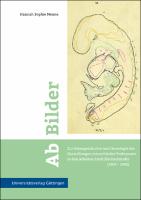(Ab)Bilder
Zur Ideengeschichte und Ikonologie der Darstellungen menschlicher Embryonen in den Arbeiten Erich Blechschmidts (1904 – 1992)
| dc.contributor.author | Menne, Hannah Sophie | |
| dc.date.accessioned | 2023-07-06T04:30:46Z | |
| dc.date.available | 2023-07-06T04:30:46Z | |
| dc.date.issued | 2023 | |
| dc.identifier.uri | https://library.oapen.org/handle/20.500.12657/63827 | |
| dc.description.abstract | Illustrations are a central component of scientific practice. They generate knowledge, shape and order it, communicate, position and discuss it at the same time. Such images, so-called epistemic images, can thus hardly be isolated from their local, social, cultural, and historical contexts. If one wants to understand the production, aesthetics, and characteristic uses of scientific images, it is necessary to take such contexts into account. The object of investigation in this thesis are the images of human embryos in the scientific work of the Göttingen anatomist Erich Blechschmidt (1904 - 1992). Initially conceived and communicated as a specialized collection, Blechschmidt's Human Embryological Documentation Collection and the images derived from it remain an anchor point for a very heterogeneous audience to this day. The work seeks explanatory approaches for the multifaceted history of the impact of Blechschmidt's images, for determining factors of their apparently enormous emotional-intuitive radiance and attraction. This is done in the sense of an iconographic-iconological analysis. The basis for this is a medical-historical investigation in the form of a reconstruction of the history of medical ideas with a focus on concepts of physiological medicine as well as a history of human embryological imaging. References to Rudolf Virchow and his cellular theory, Samuel Thomas von Soemmerring and Wilhelm His the. Ä. are presented. Translated with www.DeepL.com/Translator (free version) | |
| dc.language | German | |
| dc.subject.classification | thema EDItEUR::M Medicine and Nursing | en_US |
| dc.subject.other | epistemic images | |
| dc.subject.other | human embryos | |
| dc.subject.other | Erich Blechschmidt | |
| dc.title | (Ab)Bilder | |
| dc.title.alternative | Zur Ideengeschichte und Ikonologie der Darstellungen menschlicher Embryonen in den Arbeiten Erich Blechschmidts (1904 – 1992) | |
| dc.type | book | |
| dc.type | book | |
| oapen.identifier.doi | 10.17875/gup2023-2366 | |
| oapen.relation.isPublishedBy | ffaff15c-73ed-45cd-8be1-56a881b51f62 | |
| oapen.collection | AG Universitätsverlage | |
| oapen.description.otherlanguage | Abbildungen sind zentraler Bestandteil wissenschaftlicher Praxis. Sie generieren Wissen, formen und ordnen dies, kommunizieren, positionieren und diskutieren es zugleich. Solche Abbildungen, sogenannte epistemischen Bilder, sind damit kaum von ihren lokalen, sozialen, kulturellen und historischen Kontexten zu isolieren. Möchte man Herstellung, Ästhetik und charakteristische Gebrauchsweisen wissenschaftlicher Abbildungen verstehen, gilt es, derartige Zusammenhänge zu berücksichtigen. Untersuchungsgegenstand dieser Arbeit sind die Bilder menschlicher Embryonen im wissenschaftlichen Werk des Göttinger Anatomen Erich Blechschmidt (1904 – 1992). Die zunächst als Fachsammlung konzipierte und kommunizierte Humanembryologische Dokumentationssammlung Blechschmidt und die aus ihr abgeleiteten Abbildungen sind bis heute Ankerpunkt eines sehr heterogenen Publikums. Die Arbeit sucht nach Erklärungsansätzen für die facettenreiche Wirkungsgeschichte der Bilder Blechschmidts, nach bestimmenden Faktoren ihrer augenscheinlich enormen emotional-intuitiven Strahl- und Anziehungskraft. Dies geschieht im Sinne einer ikonographisch-ikonologischen Analyse. Grundlage hierfür bildet eine medizinhistorische Untersuchung in Form einer Rekonstruktion medizinischer Ideengeschichte mit Fokus auf Konzepte der physiologischen Medizin sowie einer Geschichte humanembryologischer Bildgebung. Bezüge zu Rudolf Virchow und seiner Zellulartherorie, Samuel Thomas von Soemmerring und Wilhelm His d. Ä. werden dargestellt. |

